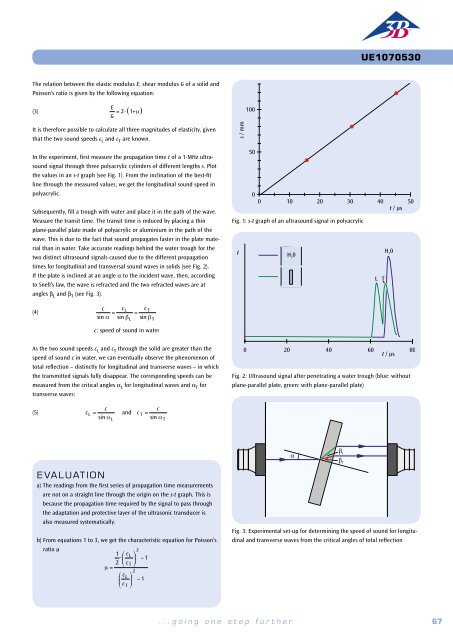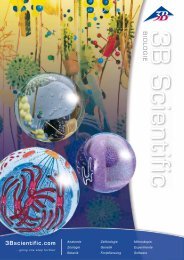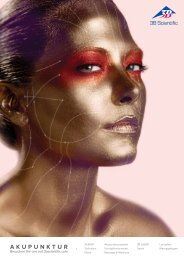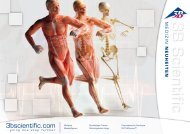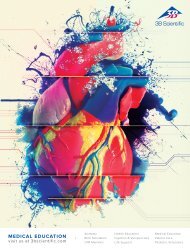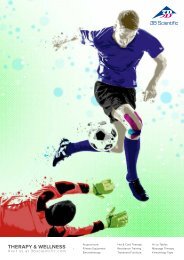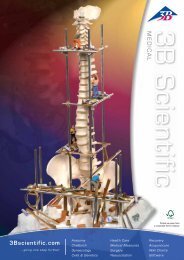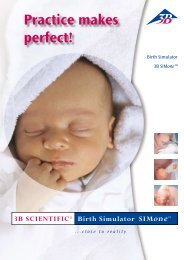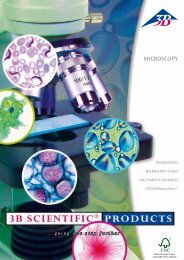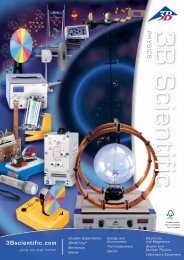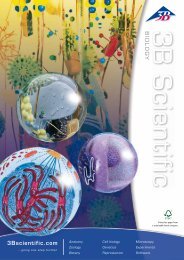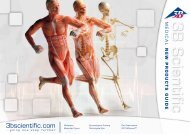3B Scientific - Physics & Engineering Experiments
3B Scientific - Physics & Engineering Experiments
3B Scientific - Physics & Engineering Experiments
You also want an ePaper? Increase the reach of your titles
YUMPU automatically turns print PDFs into web optimized ePapers that Google loves.
UE1070550<br />
Mechanics / Acoustics<br />
Debye-Sears Effect<br />
UE1070550<br />
BASIC PRINCIPLES<br />
The diffraction of light by ultrasonic waves in liquids was predicted by<br />
Brillouin in 1922, and the effect was confirmed experimentally in 1932<br />
by Debye and Sears and also by Lucas and Biquard. It is caused by the<br />
periodic variations in the refractive index of the liquid that are produced<br />
by ultrasonic waves. If a light beam is passed through the liquid<br />
perpendicular to the ultrasound direction, the arrangement acts as a<br />
phase grating, which moves depending on the velocity of sound. Its<br />
grating constant corresponds to the wavelength of the ultrasound, and<br />
thus depends on its frequency and the velocity of sound in the medium.<br />
The movement of the phase grating can be neglected if the effect is<br />
observed on a screen at a large distance.<br />
In the experiment, a vertically orientated generator couples ultrasonic<br />
waves at frequencies between 1 MHz and 12 MHz into the test liquid. A<br />
monochromatic parallel light beam passes through the liquid in the horizontal<br />
direction and is diffracted by the phase grating. The diffraction pattern<br />
contains several diffraction maxima spaced at regular distances.<br />
EVALUATION<br />
It is necessary to measure the distance s between the ultrasound generator<br />
and the screen used to observe the diffraction pattern, and the distance<br />
x 2k between the -kth and the +kth diffraction maxima. From these<br />
two distances, it is possible to calculate the diffraction angle k for the<br />
kth-order maximum, given by:<br />
x2k<br />
tan αk<br />
=<br />
2 ⋅ s<br />
This leads to the following equation for determining the ultrasound<br />
wavelength S :<br />
2⋅k<br />
⋅ s<br />
λS<br />
= ⋅λL<br />
x2k<br />
EXPERIMENT<br />
PROCEDURE<br />
OBJECTIVE<br />
Determine the velocity of ultrasonic waves in liquids<br />
The k-th-order maximum of the diffraction pattern is found at the diffraction<br />
angle α k , defined by<br />
(1)<br />
λL<br />
tan αk<br />
= k ⋅<br />
λS<br />
• Observing the diffraction pattern at<br />
a fixed ultrasound frequency for two<br />
different light wavelengths.<br />
• Observing the diffraction pattern<br />
for different ultrasound frequencies<br />
between<br />
1 MHz and 12 MHz.<br />
• Determining the corresponding sound<br />
wavelengths and the velocity of sound.<br />
SUMMARY<br />
The periodic variations of density caused by an ultrasonic standing wave pattern in a liquid act as an<br />
optical grating for the diffraction of a monochromatic parallel light beam that is transmitted in the<br />
direction perpendicular to the direction of the ultrasound wave. From the diffraction pattern and the<br />
known wavelength of the light, it is possible to determine the sound wavelength and use that to calculate<br />
the velocity of sound in the liquid.<br />
λ L : light wavelength, λ S : ultrasound wavelength.<br />
Thus, the ultrasound wavelength λ S can be determined from the separation<br />
between the diffraction maxima. Furthermore, according to the relationship<br />
(2)<br />
c = f ⋅ λ S<br />
it is possible to calculate the velocity of sound c in the liquid, since the frequency<br />
f of the ultrasonic waves is also known.<br />
Fig. 1: Diagram showing the diffraction of light by a phase grating that is<br />
produced in a liquid by ultrasonic waves (Debye-Sears effect)<br />
required apparatus<br />
Quantity Description Number<br />
1 Ultrasonic cw Generator 1002576<br />
1 Test Vessel 1002578<br />
1 Laser Diode for Debye-Sears Effect, Red 1002577<br />
1 Laser Diode for Debye-Sears Effect, Green 1002579<br />
1 Pocket Measuring Tape, 2 m 1002603<br />
1 Ultrasonic Coupling Gel 1008575<br />
Fig. 2: Sound wavelength S in water as a function of the frequency f<br />
3<br />
68 <strong>3B</strong> <strong>Scientific</strong>® <strong>Experiments</strong><br />
...going one step further<br />
69


